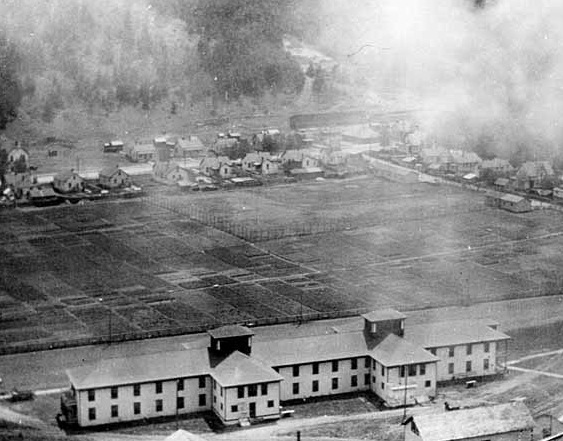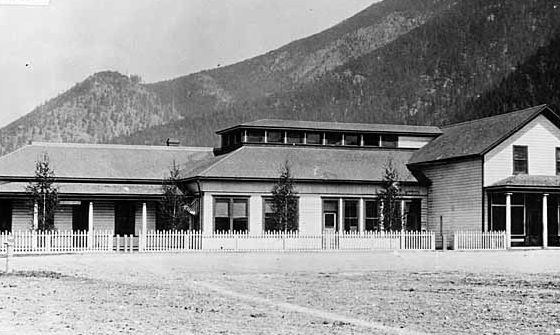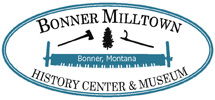 The Bonner bunkhouse and community garden. In one way or another, the Anaconda Company took care of many other aspects of a worker’s life. Housing was the major “perk.” Initially, many of the single men were housed in the bunkhouse on the mill property, while others resided at the Hotel Margaret. The foreman and skilled laborers generally lived in Bonner and leased their houses from the Company. These men lived close by the mill in case they were needed. The Company maintained these houses, or provided funds to do so, and rent was relatively inexpensive. Steam heat was provided to houses on the same side of the road as the mill, and residents living on the other side of the road could buy scrap wood for $2 a load. Sawdust, for use in houses with sawdust burners, could be purchased for $24 a year. The Company also cut ice and delivered it to the employees in the days before refrigeration. Even still by the 1950s, 75 percent of the families in Bonner worked at the mill; by 1980 though this number was reduced to 35 percent.
The Bonner bunkhouse and community garden. In one way or another, the Anaconda Company took care of many other aspects of a worker’s life. Housing was the major “perk.” Initially, many of the single men were housed in the bunkhouse on the mill property, while others resided at the Hotel Margaret. The foreman and skilled laborers generally lived in Bonner and leased their houses from the Company. These men lived close by the mill in case they were needed. The Company maintained these houses, or provided funds to do so, and rent was relatively inexpensive. Steam heat was provided to houses on the same side of the road as the mill, and residents living on the other side of the road could buy scrap wood for $2 a load. Sawdust, for use in houses with sawdust burners, could be purchased for $24 a year. The Company also cut ice and delivered it to the employees in the days before refrigeration. Even still by the 1950s, 75 percent of the families in Bonner worked at the mill; by 1980 though this number was reduced to 35 percent.
In Milltown the ownership pattern was different. Lots in Milltown were leased--first from William Clark’s realty company and later from Anaconda or, in a few cases, from the Northern Pacific Railroad. Lots rented for $2 per year for 50 years. However, the houses themselves were built and owned by the tenants, most of whom were laborers of the mills. There were also several boarding houses in Milltown for single men. Only in the last few years have residents of Milltown been able to purchase the land beneath their houses.
In West Riverside, both lots and homes were owned by individual residents from the beginning. Unlike Anaconda, the Western did not provide houses for their management. C. H. Richardson, manager of the Western, bought one of the first lots in West Riverside and built his home there. The company store operated until
The company store operated until
the unions arrived in 1942. The Company store allowed workers to run up credit for several months. Many of the families were large, with seven or eight children, and this helped making ends meet. The store stocked everything from groceries and drugstore items to work clothes. Groceries were delivered to the households. Mill workers could also get purchase orders to shop at the Missoula Mercantile. The prices charged by the store were the same as other stores and then the company gave a 10% discount. The Company policy was not to make a profit on the food sold to employees. When the union came in 1942, the Company Store was closed.
Every Christmas employees would receive a turkey or a 100-pound sack of flour. Children would receive a bag of sweets delivered through the school. The school itself was heavily dependent on the mill. Anaconda leased the land for the first school to the school Board but donated the land for the second school. They provided slab wood to heat the school building. Books, paper, pens etc, were all furnished. The mill manager was usually a member of the Board of Trustees. In general, the Company was a strong supporter of school activities.
The Company also contributed to the University of Montana, in particular for the Lubrecht Forest, which was created through the donation of more than 19,000 acres in 1937.
The Company also provided the large hoses and water for fire protection, a job now undertaken by the Missoula Rural Fire Department. The Company organized the Blackfoot Forest Protective Association to fight fires on non-Federal and non-tribal lands. Fires were a constant threat in Milltown and Bonner, and the Mill itself burned in 1919.
